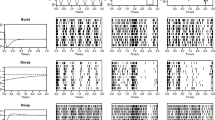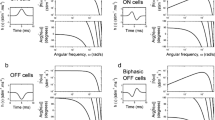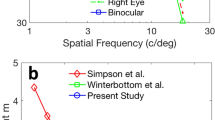Summary
-
1.
A simple model is described which establishes a relationship between physiological and psychophysical flicker-fusion data. The three components of the model are a transducer, a filter and a flicker-detector. The model is consistent with the view that fusion is purely retinal.
-
2.
An electronic analog is used to realize the model. Its essential elements are a source of generator pot1ential, a low-pass filter, and a simulated ganglion cell.
-
3.
The model was originally designed to reproduce the psychophysical results obtained by de Lange. Special importance is attached to the envelope of his curves; the model reproduces this envelope. His low-intensity results are duplicated accurately, while the high-intensity, high-frequency data are derived somewhat less accurately. The high-intensity low-frequency data are attributed to a mechanism not included in the model.
-
4.
In the simulation of physiological data obtained by Enroth, close resemblance to the firing characteristics of retinal ganglia in cat is shown by the model. Firing occurs for bursts lasting for at most half the period of the alternating stimulus, the number of spikes per burst diminishing to unity as “fusion” is approached.
-
5.
The phase lags and latencies of responses in the model satisfy neurophysiological evidence. Both off-latency and inhibition-latency are satisfactorily reproduced.
-
6.
The model has been used to simulate two-component flicker data. The “flicker-detector” employed leads to results very similar to those obtained psychophysically. The phase characteristics of the assumed filter agree less well.
Similar content being viewed by others
References
Bartley, S. H., and T. M. Nelson: A further study of pulse-to-cycle fraction and critical flicker frequency. A decisive theoretical test. J. opt. Soc. Amer. 51, 41 (1961).
Brown, C. R., and D. M. Forsyth: Fusion contour for intermittent photic stimuli of alternating duration. Science 129, 390 (1959).
Enroth, Christina: The mechanism of flicker and fusion studied on single retinal elements in the dark adapted eye of the cat. Acta physiol. scand. 27, Suppl. 100, 1 (1952).
Granit, R., and P. O. Therman: Excitation and inhibition in the retina and in the optic nerve. J. Physiol. (Lond.) 83, 359 (1935).
Harmon, L. D.: Studies with artificial neurons. I. Properties and functions of an artificial neuron. Kybernetik 1 (1961).
Hartline, H. K.: The response of single optic nerve fibres of the vertebrate eye to illumination of the retina. Amer. J. Physiol. 121, 400 (1938).
Hcnht, S., and C. D. Verrijp: The influence of intensity, colorae d retinal location on the fusion frequency of intermittent illumination. Proc. nat. Acad. Sci. (Wash.) 19, 522 (1933).
Ives, H. E.: Critical frequency relations in scotopic vision. J. opt. Soc. Amer. 6, 254 (1922a).
—A theory of intermittent vision. J. opt. Soc. Amer. 6, 343 (1922b).
Kelly, D. H.: Effects of sharp edges in a flickering field. J. opt. Soc. Amer. 49, 730 (1959)
—Systems analysis of the human visual process. Ph. D. Thesis, Engineering Dept., Univ. of California, Los Angeles (1960); - Flicker fusion and harmonic analysis. J. opt. Soc. Amer. 51, 917 (1961).
Landis, C.: An annotated bibliography of flicker fusion phenomena. Ann Arbor: Armed Forces National-Research Council, Vision Committee Secretariat 1953.
Lange, H. de, Dzn.: Experiments on flicker and some calculations on an electrical analogue of the foveal systems. Physica 18, 935 (1952); - Relationship between critical flicker-frequency and a set of low-frequency characteristics of the eye. J. opt. Soc. Amer. 44, 380 (1954); - Research into the dynamic nature of the human fovea—cortex systems with intermittent and modulated light. I. Attenuation characteristics with white and colored light. J. opt. Soc. Amer. 48, 777 (1958); - Eye's response at flicker fusion to square-wave modulation of a test field surrounded by a large steady field of equal mean luminance. J. opt. Soc. Amer. 51, 415 (1961).
Levinson, J.: Fusion of complex flicker. Science 130, 919 (1959); - Fusion of complex flicker. II. Science 131, 1438 (1960).
Lindsley, D. B.: Brain organization for perception; temporal and integrated aspects in vision. Cerebral Systems and Computer Logic Symposium. Pasadena: Cal. Inst. Tech. 1960.
Ross, R. T.: The fusion frequency in different areas of the visual field. III. Foveal fusion frequency and the light-dark ratio for constant retinal illumination at fusion. J. gen. Psychol. 18, 111 (1938).
Svaetichin, G.: Receptor mechanisms for flicker and fusion. Acta physiol. scand. 39, Suppl. 134, 47 (1956).
Author information
Authors and Affiliations
Additional information
We are indebted to C. Enroth, H. de Lange, Dzn. and D. H. Kelly for their stimulating and helpful correspondence.
Rights and permissions
About this article
Cite this article
Levinson, J., Harmon, L.D. Studies with artificial neurons, III: mechanisms of flicker-fusion. Kybernetik 1, 107–117 (1961). https://doi.org/10.1007/BF00290181
Received:
Issue Date:
DOI: https://doi.org/10.1007/BF00290181




